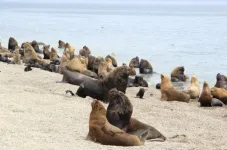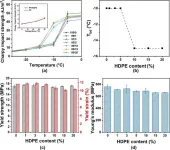(Press-News.org) Philadelphia, March 7, 2025 – After many decades of research, the dairy sector has a significant body of peer-reviewed research showing that feed additives can effectively reduce methane, the greenhouse gas that makes up most of dairy’s environmental footprint. Yet the practical use of this knowledge on farms—as well as general awareness around additive effectiveness and safety—is still gaining momentum. At this critical point in the dairy sector’s pathway to a net-zero future, the Journal of Dairy Science, the leading general dairy research journal from the American Dairy Science Association (ADSA), published by Elsevier, has released a special issue translating this nutrition innovation into detailed technical recommendations on developing and implementing feed additives. The result is a feed additive toolkit to help researchers, dairy professionals, product developers, producers, and consumers fill knowledge gaps and supercharge feed additive adoption to reduce dairy’s environmental footprint today and into the future.
This issue, Feed Additives for Methane Mitigation, presents the first outcomes of a flagship project by the Feed and Nutrition Network of the Global Research Alliance on Agricultural Greenhouse Gases’ Livestock Research Group. David Yáñez-Ruiz, PhD, of the Spanish Research Council (CSIC; Granada, Spain), one of the project’s co-leads, explained, “This collaborative effort gathered 60 leading researchers from 46 institutions across 23 countries to form a robust network of scientists dedicated to reducing methane emissions from ruminants, which is a crucial goal as we combat climate change.”
André Bannink, PhD, of Wageningen University & Research (Wageningen, the Netherlands), the second co-lead of this initiative, added, “Our goal is to provide the scientific community and livestock sector with technical guidelines on best practices for developing and testing feed additives, which we know is currently our most powerful methane-reduction tool.”
The issue’s introduction provides an overview of all six articles and explains the overall goals of the project team. Journal of Dairy Science Guest Editor Michael Kreuzer, PhD, professor emeritus at ETH Zurich (Lindau, Switzerland), explained, “Because of huge scientific leaps forward, we, as a society, now have the technical knowledge available to help each country, region, and farm find a path to methane reduction tailored to their unique need. It’s time then to turn the attention of scientists, extensionists, industry, and farmers to the actual application of this knowledge on a broader scale.”
The first step in developing feed additives is to find and test the actual bioactive compounds that inhibit methane produced by microorganisms in the digestive tract of animals. The guidelines open with recommendations for this process, including two different approaches for selecting the compounds—empirical (screening compounds already identified in databases) or mechanistic (discovering new and unidentified compounds based on our knowledge of animal biology). Once selected, the authors outline the initial lab tests needed to understand the compounds’ impact on methane, considering factors such as dosage, formulation, and how they might interact with an animal’s diet and the complex microbial fermentation in the rumen.
Once tested in a lab, the next step is to trial feed additives with animals to understand their efficacy and safety. The second article in the special issue provides guidelines for designing and conducting these studies to meet the most rigorous standards, including techniques for measuring enteric methane emissions. The guidelines also cover analyzing the resulting data to determine the feed additives’ efficacy in achieving methane reduction and, critically, the safety of these additives for the animals consuming them and the nutritional composition of the final milk and meat products.
As these feed additives are introduced under various farming conditions, future modeling will become increasingly important to understand their effects at different scales and in varying environments. The third article in the special issue includes recommendations and guidelines for modeling the effects of feed additives, including the type of models used, the modeling objectives, and data availability while accounting for synergies and trade-offs. The authors’ recommendations present modeling approaches for understanding an additive’s impact on methane emissions at the farm and national, regional, and global levels.
Dr, Kreuzer commented, “As we work toward a shared and comprehensive understanding of methane-mitigating feed additives, one key gap we need to fill is exactly how these compounds work—or their mode of action.”
The issue’s fourth article explores the best approaches for elucidating the microbiological and biochemical changes that occur when additives are incorporated into a ruminant’s diet. The authors explain that uncovering the mode of action can be a difficult and costly task involving specialized equipment, facilities, and resources. This stage of testing involves identifying which microbes are targeted by the additive to understand the mechanisms happening at the cellular and molecular levels and to map the pathways where the active compounds can be degraded in the animals’ digestive tract. Understanding the specific mode of action of each compound is critical for providing appropriate use recommendations for different livestock production systems. They recommend conducting this research only after lab and animal studies have shown an additive’s effectiveness and safety.
All this testing and modeling lead to the ultimate goal of getting methane-reducing feed additives authorized and approved for official commercial use, which is the topic of the next article in the special issue. Although exact requirements differ from country to country, all additive regulations are enforced to ensure the health and safety of the animals consuming them, the workers manufacturing and handling them, and the consumers enjoying the finished dairy products. The approval process also requires proof that additives are effective for their specific purpose and puts consumer-production guardrails around misleading marketing claims. The authors synthesize the legislation and legal procedures in Australia, Canada, the European Union, New Zealand, South Korea, the United Kingdom, and the United States as examples, offering actionable recommendations for both scientists and applicants seeking official feed additive authorization.
Once approved and deployed commercially, the question, “What kind of emissions impact can we anticipate from these additives in our complex global farming systems?” looms. The special issue concludes with a final article with recommendations for quantifying methane reduction—from individual animal measurements to national-level inventories. It emphasizes the importance of considering factors like the specific additive used, its delivery method, and potential impacts on other parts of the livestock production system. The result is a framework for accurately assessing the potential environmental benefits of feed additives, which is crucial for promoting their widespread adoption and supporting effective emission-mitigation strategies across the livestock sector.
Together, these six articles detail robust technical recommendations from additive development to impact measurement and provide actionable best practices and a roadmap with the potential to contribute significantly to global livestock climate efforts.
Explaining the significance of the special issue, the journal’s editor in chief, Paul Kononoff, PhD, added, “These guidelines represent an enormous, interconnected global effort to ensure that tomorrow’s dairy and livestock sectors can both continue to provide essential nutrition and contribute to a more sustainable future.”
Explore the insights from the special issue via a recorded webinar with the authors, and join them for an in-depth, half-day symposium at the 2025 ADSA Annual Meeting taking place June 22-25 in Louisville, Kentucky.
END
New technical guidelines pave the way for widespread adoption of methane-reducing feed additives in dairy and livestock
In a special issue of the Journal of Dairy Science a global team of experts synthesizes decades of nutrition innovation on feed additives for methane reduction
2025-03-07
ELSE PRESS RELEASES FROM THIS DATE:
Eradivir announces Phase 2 human challenge study of EV25 in healthy adults infected with influenza
2025-03-07
WEST LAFAYETTE, Ind. — Eradivir, a clinical-stage small molecule immunotherapy biotech company, announced it has begun a Phase 2 challenge study with its antiviral therapeutic, EV25. The study will provide safety and efficacy data gathered from otherwise healthy participants infected with influenza then later treated with EV25.
EV25 was built on a platform created in Philip Low’s lab. Low is the Presidential Scholar for Drug Discovery and the Ralph C. Corley Distinguished Professor of Chemistry in Purdue University’s College of Science. Low is Eradivir’s chief scientific officer and on its board of directors.
The European Medicines ...
New study finds that tooth size in Otaria byronia reflects historical shifts in population abundance
2025-03-07
Puerto Madryn, Argentina – A new study published in PeerJ Life and Environment reveals that the teeth of South American sea lions (Otaria byronia) hold valuable clues about past population dynamics. Researchers from the Instituto de Biología de Organismos Marinos, the Centro para el Estudio de Sistemas Marinos, and the Universidad Nacional de la Patagonia San Juan Bosco analysed changes intooth size and growth layer groups (GLGs) over the ...
nTIDE March 2025 Jobs Report: Employment rate for people with disabilities holds steady at new plateau, despite February dip
2025-03-07
East Hanover, NJ – March 7, 2024 – The employment rate for people with disabilities saw a slight dip in February but continued to fluctuate around a steady plateau of approximately 37.5%. While these dips can trigger speculation about broader policy implications, nTIDE experts cautioned that it is premature to attribute changes to recent shifts in federal employment policies. The employment-to-population ratio for people with disabilities remained stable. nTIDE is issued by Kessler Foundation and the ...
Breakthrough cardiac regeneration research offers hope for the treatment of ischemic heart failure
2025-03-07
Researchers in the Michael E. DeBakey Department of Surgery at Baylor College of Medicine, the QIMR Berghofer Medical Research Institute in Brisbane, Australia, and collaborating institutions report a groundbreaking discovery in cardiac regeneration that offers new hope for the treatment of ischemic heart failure. Published in npj Regenerative Medicine, the study reveals a novel approach to promoting cardiomyocyte proliferation.
“When the heart cannot replace injured cardiomyocytes with healthy ones, it becomes progressively ...
Fluoride in drinking water is associated with impaired childhood cognition
2025-03-07
Elevated concentrations of fluoride can occur in well water, and in some countries, it is added to drinking water to counteract caries in the population. A study from Karolinska Institutet in Sweden now supports a few previous studies indicating that exposure to fluoride during the fetal stage or early childhood may impair cognition in children. The study is published in the journal Environmental Health Perspectives.
Fluoride occurs naturally as fluoride ions in drinking water, but the concentrations are generally low in ...
New composite structure boosts polypropylene’s low-temperature toughness
2025-03-07
A recent study published in Engineering presents a significant advancement in improving the toughness of polypropylene (PP), a widely used thermoplastic material. The research, led by Zhiyi Zhang and Qiang Zheng from Taiyuan University of Technology and Zhejiang University, focuses on developing a novel core–shell structured composite to enhance PP’s performance at low temperatures.
PP has many advantages, such as high thermal and chemical resistance, but its low-temperature toughness is a limiting ...
While most Americans strongly support civics education in schools, partisan divide on DEI policies and free speech on college campuses remains
2025-03-07
A new report looking at adults’ views on education topics shows more partisan agreement about how to educate students for citizenship than many might think, yet sharp partisan divide around issues of diversity, equity and inclusion policies on college campuses and free speech.
The report, published by the USC Center for Applied Research in Education, a center housed within USC Dornsife’s Center for Economic and Social Research, in partnership with the USC EdPolicy Hub, is based on a nationally representative, probability-based ...
Revolutionizing surface science: Visualization of local dielectric properties of surfaces
2025-03-07
Researchers from the University of Electro-Communications (Akira Sumiyoshi and Jun Nakamura) and Tohoku University (Kohei Yamasue and Yasuo Cho) have made a significant advancement in visualizing the local dipole moments at the semiconductor surface. This study offers unprecedented insights into the atomic-scale charge distribution and dipole configuration using a combination of the scanning nonlinear dielectric microscope (SNDM) and advanced density functional theory (DFT) calculations.
The ...
LearningEMS: A new framework for electric vehicle energy management
2025-03-07
A new study published in Engineering introduces LearningEMS, a unified framework and open-source benchmark designed to revolutionize the development and assessment of energy management strategies (EMS) for electric vehicles (EVs).
The automotive industry has recently undergone a transformative shift fueled by the growing global emphasis on sustainability and environmental conservation. EVs have become a crucial part of the future of transportation. However, effectively managing the energy in EVs, especially those with complex power ...
Nearly half of popular tropical plant group related to birds-of-paradise and bananas are threatened with extinction
2025-03-07
A new analysis from researchers at the Smithsonian’s National Museum of Natural History reveals that nearly half of the genus Heliconia, a group of tropical plants popular for their bright, beak-shaped flowers, are threatened with extinction. The findings, published today, March 7, in the journal Plants, People, Planet, reveal that many of these imperiled plants are not found within protected areas or botanical gardens, making additional conservation action crucial to saving these charismatic, horticulturally important and ecologically significant floras.
The new work places Heliconia among a select group of plants to undergo a detailed, comprehensive ...
LAST 30 PRESS RELEASES:
Deep neural networks enable accurate pricing of American options under stochastic volatility
Collective risk resonance in Chinese stock sectors uncovered through higher-order network analysis
Does CPU impact systemic risk contributions of Chinese sectors? Evidence from mixed frequency methods with asymmetric tail long memory
General intelligence framework to predict virus adaptation based on a genome language model
Antibiotic resistance is ancient, ecological, and deeply connected to human activity, new review shows
Vapes, pouches, heated tobacco, shisha, cigarettes: nicotine in all forms is toxic to the heart and blood vessels
From powder to planet: University of Modena engineers forge a low-carbon future for advanced metal manufacturing
Super strain-resistant superconductors
Pre-school health programme does not improve children’s diet or physical activity, prompting call for policy changes, study finds
Autumn clock change linked to reduction in certain health conditions
AI images of doctors can exaggerate and reinforce existing stereotypes
Where medicine meets melody – how lullabies help babies and parents in intensive care
We may never be able to tell if AI becomes conscious, argues philosopher
AI video translation shows promise but humans still hold the edge
Deep ocean earthquakes drive Southern Ocean’s massive phytoplankton blooms, study finds
Without campus leftovers to pick through, the beaks of this bird changed shape during the pandemic
High-dose antibiotic does not reduce mortality in tuberculous meningitis
How many insects fly in the sky above the USA?
Could cheese protect your brain health?
Who faces more difficulty recovering from stroke?
Colliding galaxies create the brightest, fastest growing black holes at their center
New BrainHealth research reveals tradeoffs on sleep with cannabis use for chronic pain
Aging-US now on ResearchGate, enhancing visibility for authors and readers
'Molecular glue' stabilizes protein that inhibits development of non-small cell lung cancer
Mount Sinai Health System is recognized in 2025 Chime Digital Health Most Wired survey
From prey to predator: How carnivores spread beneficial fungi
Menopause symptoms may be frequent and have negative effects, according to female endurance athletes
US Congressmembers’ responses on X to mass shooting events differ along party lines
KAIST-UEL team develops “origami” airless wheel to explore lunar caves
Individual genetic differences render some therapies ineffective
[Press-News.org] New technical guidelines pave the way for widespread adoption of methane-reducing feed additives in dairy and livestockIn a special issue of the Journal of Dairy Science a global team of experts synthesizes decades of nutrition innovation on feed additives for methane reduction





